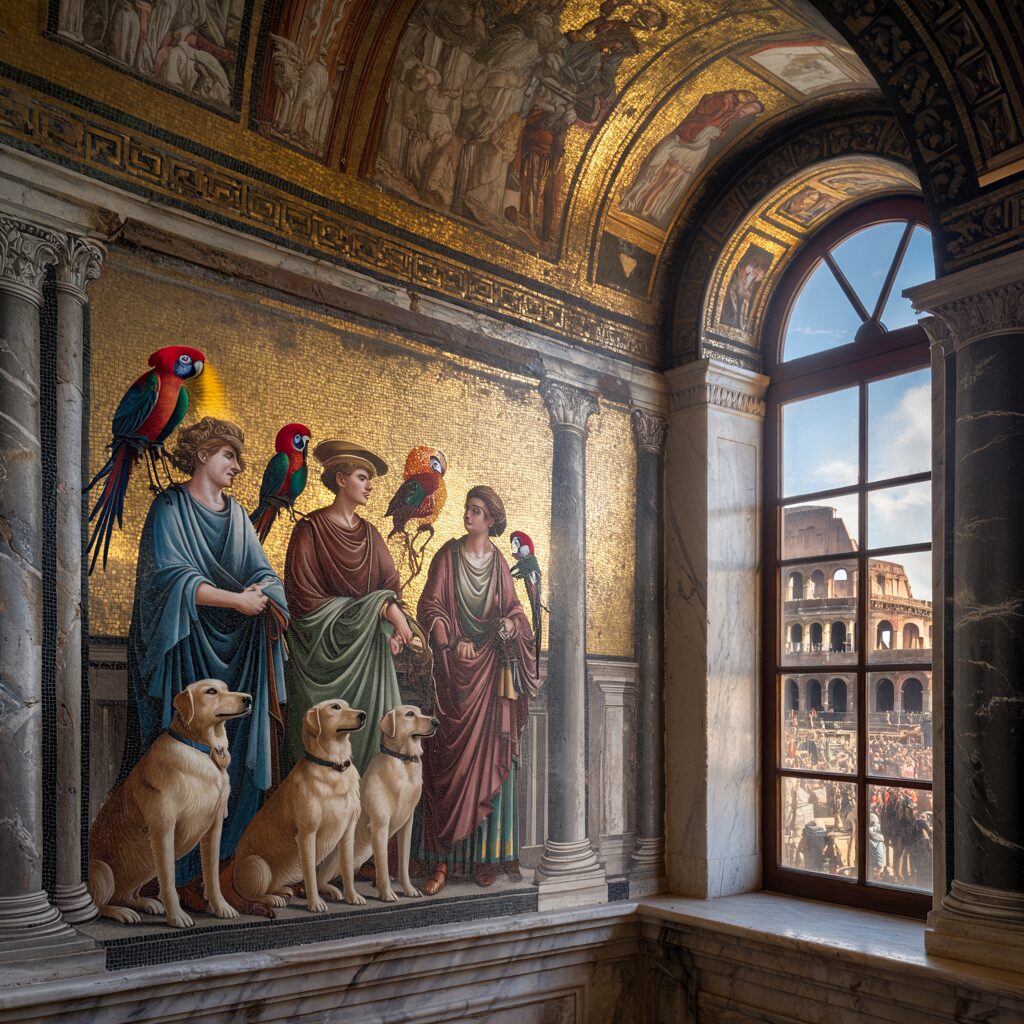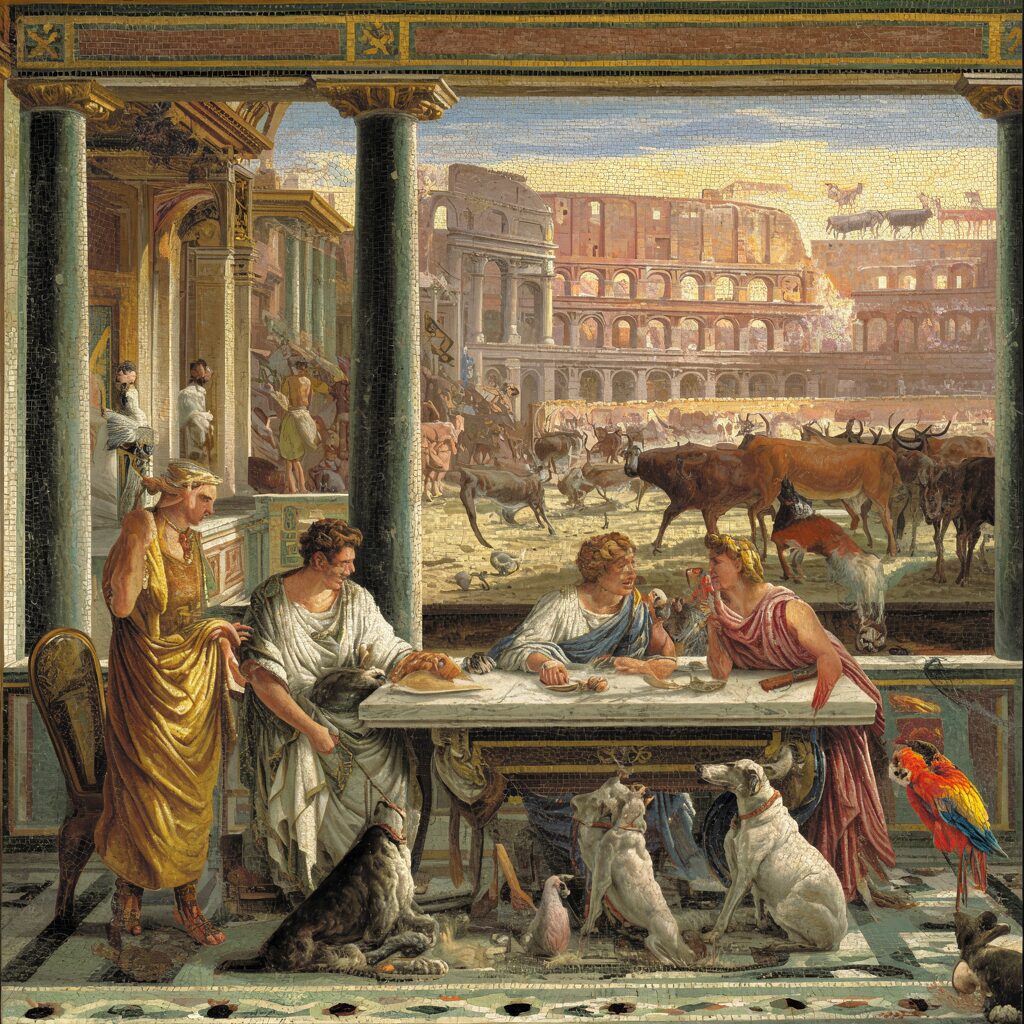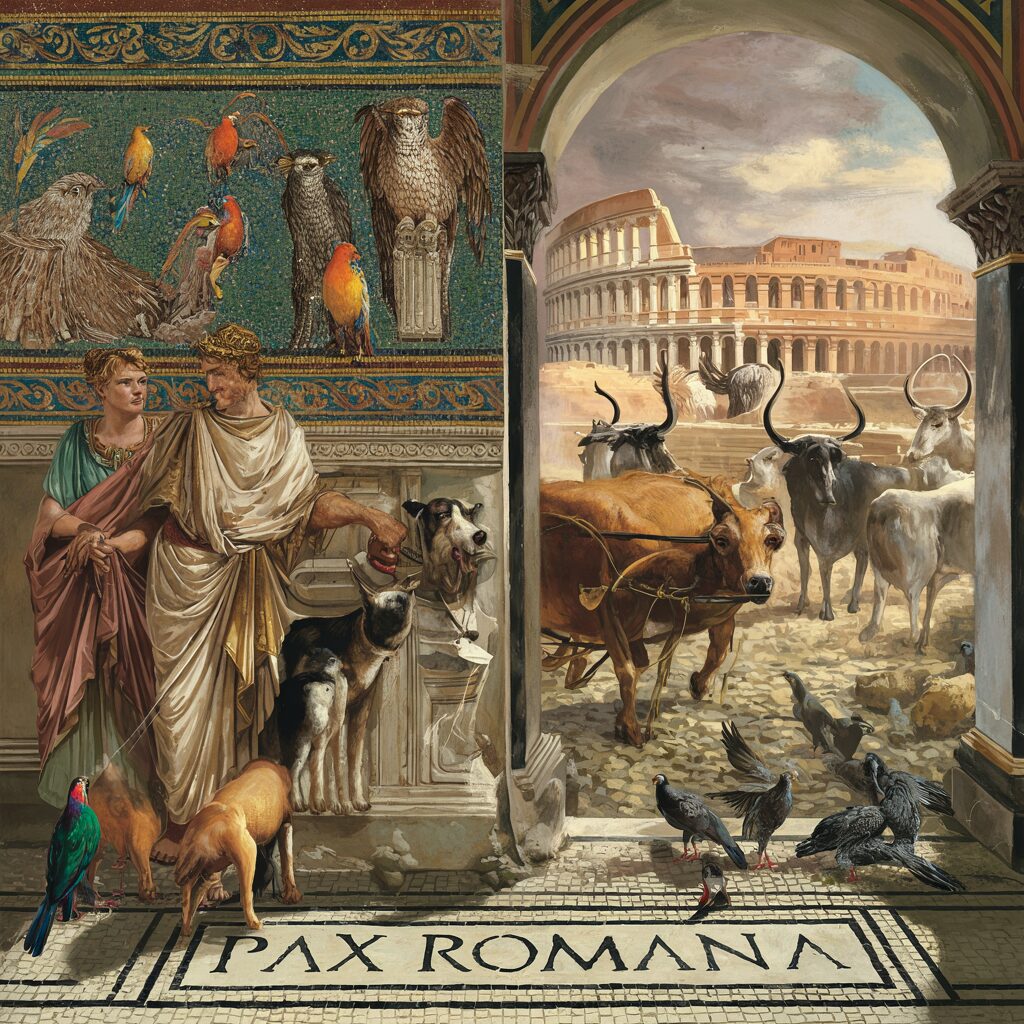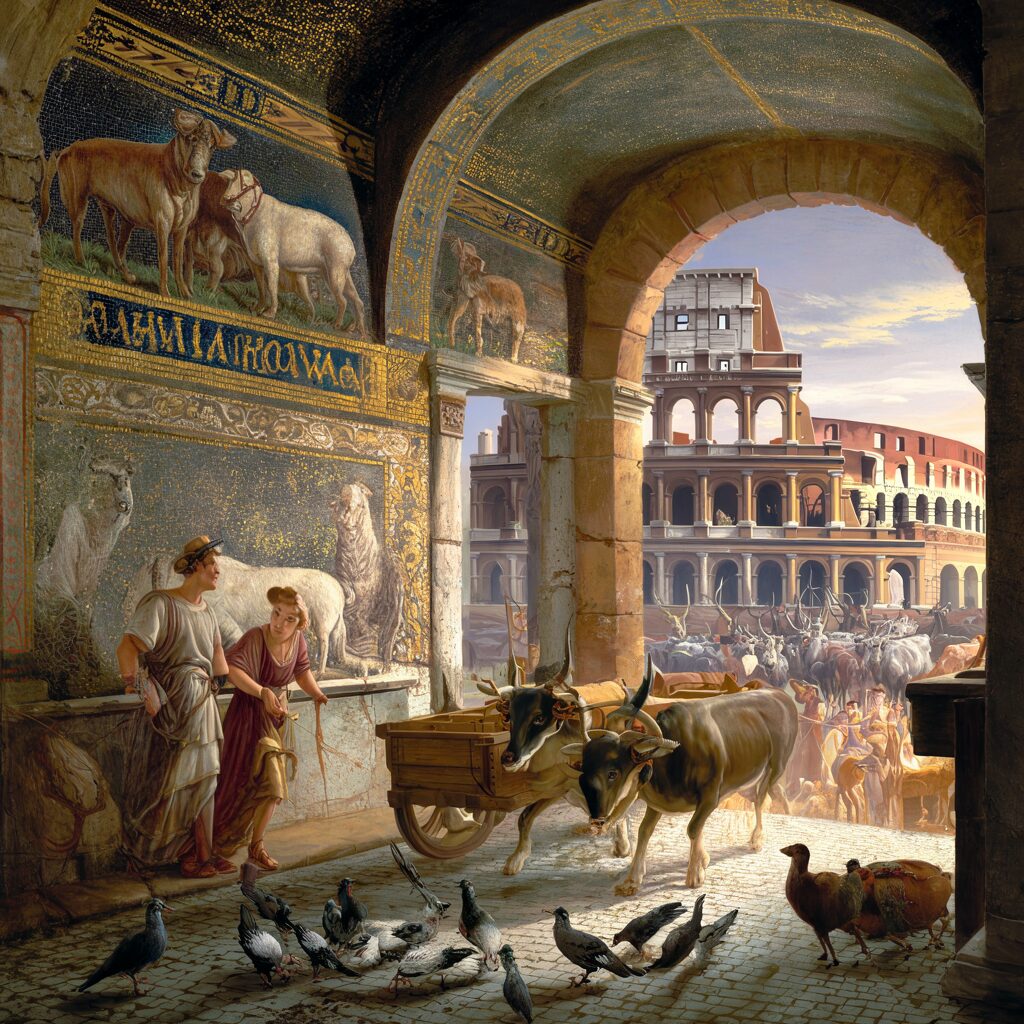The world of Ancient Rome, with its rich history and fascinating culture, offers a captivating subject for exploration. From the gladiators and chariot races that entertained the masses to the intricate social class divide that defined daily life, every aspect tells a unique story.
The patricians, known as the masters of Roman luxury and power, lived a life of privilege, while the plebeians faced a starkly different reality. Yet, despite these differences, the cultural and social fabric of Ancient Rome was woven together through shared experiences such as public spectacles and communal events.
Our website serves as your ultimate online resource dedicated to unraveling the mysteries of Ancient Rome, spanning from its origins as a Republic to its transformation into a mighty Empire. Whether you’re an enthusiast or a scholar, we provide engaging content that brings this ancient civilization to life.

Roles of Animals in Ancient Roman Society
Pets and Domestic Companions
Animals in Ancient Rome served multiple roles, with a significant presence as pets and domestic companions. Roman households often included animals such as dogs, cats, birds, and even small exotic creatures. These pets were more than mere property; they formed emotional connections with their owners, reflected in literature, art, and archaeological finds.
Common pets kept by Romans:
- Dogs were the most popular companions. Romans bred different types for specific purposes—guard dogs protected homes, while smaller breeds served as lapdogs or companions. Dogs appear frequently in mosaics, frescoes, and epitaphs, highlighting their valued role.
- Cats became common in Roman households primarily to control pests like mice. Despite being less prominent than dogs in artistic depictions, cats were appreciated for their utility and companionship.
- Birds, including songbirds like nightingales and parrots imported from far regions, symbolized status and added to the domestic ambiance.
- Small mammals such as ferrets and occasionally monkeys also featured among Roman pets.
Evidence from both literature and archaeology demonstrates the care given to these animals. For example:
- Tomb inscriptions sometimes commemorate beloved pets by name, indicating strong emotional bonds.
- Mosaics found in villas depict dogs lying peacefully beside their owners or children playing with animals.
- Writers such as Ovid mention the affectionate relationships between humans and their pets.
Poetry and art reveal tenderness toward animals that contrasts sharply with other uses of animals in Roman society. Virgil’s Georgics includes passages praising the loyalty of dogs. Pliny the Elder describes the intelligence of certain animals and advises humane treatment. Pet funerals were not uncommon; some Romans buried their pets with grave goods or dedicated monuments.
Roman pets often had symbolic meanings tied to family life and protection but were also genuine companions sharing daily routines. This dual role is evident in household artifacts like collars inscribed with names or protective charms designed for pets.
In addition to companionship, many animals worked alongside humans—horses carried riders or pulled chariots, oxen plowed fields, while pigeons served communication purposes. Yet pets remained distinct for their domestic intimacy.
The presence of pets in Ancient Rome highlights a complex relationship: animals were integrated into private life with affection even as others faced exploitation for labor or spectacle. This complexity sets the stage for understanding how sacred roles and public uses of animals intertwined within Roman culture.

Sacred and Symbolic Animals
Animals in Ancient Rome served roles extending beyond companionship or labor. Some species held sacred status, deeply woven into Roman religion and spirituality. These sacred animals were often seen as messengers or manifestations of the gods, bridging the human and divine realms.
Key examples include:
- Owls, associated with Minerva, goddess of wisdom, symbolizing insight and protection.
- Wolves, revered for their connection to Romulus and Remus, Rome’s legendary founders believed to be suckled by a she-wolf.
- Sacred serpents, regarded as guardians of household hearths and linked to the Lares, protective spirits of the home.
- Eagles, emblematic of Jupiter, king of the gods, representing power and authority.
Ritual use often involved offering animals during sacrifices or observing animal behavior as omens. The presence of these animals in temples and public ceremonies revealed their spiritual significance.
Animal worship reflected complex Roman attitudes—while many animals were exploited as beasts of burden or spectacle animals in gladiatorial games, others earned reverence through religious symbolism. This duality illustrates how animals operated on multiple levels: from pets in Ancient Rome to sacred intermediaries influencing fate and divine favor.
Such sacred roles underscore an important facet of Animal Welfare in Ancient Rome: From Pets to Sacred Animals, highlighting how cultural values shaped human-animal relationships beyond mere utility.
In addition to these cultural aspects, it’s interesting to note how the legacy of ancient Rome continues to influence modern society. For instance, role-playing games like Second Life allow players to immerse themselves in a virtual world reminiscent of ancient Roman culture. Such experiences offer a unique perspective on how historical narratives can be explored and understood today.
Moreover, understanding the structure of power during the Roman Republic can provide valuable insights into the political dynamics that shaped this era. This period marked a significant transition in governance from monarchy to a complex political structure, laying the foundation for modern democracies.
Additionally, exploring the role of agriculture during this time reveals how it was a crucial driver of Rome’s economic growth. The insights from this article highlight how this sector extended beyond mere food production and significantly influenced social development.
Lastly, figures like Scipio Africanus played pivotal roles in shaping Roman history. His victories during the Second Punic War not only established Rome’s dominance over Carthage but also changed the course of history. More about his impact can be found here.

Animals in Entertainment and Public Spectacles
Roman society showcased animals in a variety of public spectacles, reflecting the complex relationship between humans and animals beyond domestic companionship or sacred symbolism. The Colosseum and other arenas were stages for dramatic displays involving:
- Bulls, often pitted against gladiators or other beasts.
- Stags hunted as part of venationes (wild beast hunts).
- Crocodiles and serpents, exotic creatures used to astonish crowds and heighten the spectacle’s danger.
These events were marked by blatant cruelty. Animals faced brutal treatment, from being forced into violent combat to suffering agonizing deaths for the amusement of spectators. Such spectacles demonstrated Roman power over nature, emphasizing entertainment through domination and death.
Despite the inherent cruelty, these games enjoyed massive popularity. Public attendance was seen as a civic duty or social expectation. The spectacle animals were not only performers but symbols of imperial grandeur and control. This widespread acceptance of animal suffering coexisted with the more personal roles animals played as pets in Ancient Rome or their revered status as sacred animals.
Animals served multiple societal functions—pets in Roman households like dogs and cats offered companionship; working animals supported agriculture and transport; sacred animals held spiritual significance; spectacle animals entertained vast audiences while enduring harsh conditions. The paradox of admiration mixed with exploitation highlights the diverse uses and perceptions of animals in Roman culture.
The role of gladiators in these spectacles is particularly noteworthy. They were brave warriors admired for their skills in battle, yet they were also victims of a complex social system that exploited their talents for entertainment.

Philosophical Perspectives on Animal Welfare in Ancient Rome
Roman philosophy on animals generally placed them outside the realm of moral consideration. Animals were seen as irrational beings, lacking reason and therefore excluded from ethical duties owed by humans. This dominant view justified their use as property or instruments to fulfill human needs without moral restraint.
Some Roman thinkers challenged this perspective:
Seneca, a prominent Stoic philosopher whose ideas significantly shaped Roman thought, expressed concern for animal suffering, urging kindness and empathy toward all living creatures. His writings imply a recognition of animal sentience and an ethical obligation to minimize cruelty.
Plutarch advocated vegetarianism, criticizing the unnecessary harm caused by meat consumption. He linked abstaining from animal flesh to moral virtue and compassion, positioning it as a higher ethical standard.
Plotinus, influenced by Neoplatonism, emphasized the spiritual interconnectedness of all life forms. His ethics suggested respect for animals as part of the cosmic order, encouraging humane treatment based on metaphysical principles.
Despite these reflections, practical realities often conflicted with philosophical ideals. Animals remained essential for labor, food, and entertainment in Roman society, particularly for the plebeians, who comprised the majority of the population and significantly influenced the development of political and economic structures. The coexistence of utilitarian exploitation and philosophical advocacy highlights a complex relationship where kindness was promoted in theory but frequently compromised in practice.
This intricate dynamic is further exemplified in various aspects of art and culture during that era. The artistic expressions from this period reflect not only the aesthetic values but also the societal norms, including the treatment of animals which were often depicted in sculptures and mosaics.

Legal Status and Rights of Animals in Ancient Rome
The legal status of animals in Ancient Rome was primarily determined by ius, the Roman principle of law and rights. This system regulated human relationships and property but did not give significant legal consideration to animals. Instead, animals were mainly seen as property or, in some cases, as slaves (servi), highlighting their practical role in society rather than any acknowledgment of inherent rights.
Key Aspects of Roman Legal Views on Animals
Here are some important points about how Romans viewed animals legally:
- Animals as Property: Animals were assets owned by individuals or the state. Ownership rights allowed control over their use, sale, and disposal without legal consequences based on animal welfare.
- Animals as Slaves: Certain animals were treated similarly to slaves under law, especially those performing labor like horses or dogs. This classification reinforced the view of animals as objects serving human interests.
- Absence of Animal Rights: The idea that non-human beings could have rights was mostly absent. There were no formal protections against cruelty unless it affected human owners’ property interests.
- Legal Protections Focused on Humans: Laws addressing animal abuse typically aimed to prevent economic loss or social disruption rather than tackle animal suffering.
The strict limits of ius in Roman law show how deeply ingrained the belief was that animals had no moral or legal status beyond being owned. This legal background influenced how people interacted with animals throughout Roman society, shaping practices from caring for pets at home to using them in public entertainment.
The conflict between philosophical thoughts on compassion and the rigid legal perspective reveals the tensions in Ancient Rome’s approach to animal welfare, laying the groundwork for future discussions about the history of animal rights.
To better understand this context, it’s essential to consider how foundational elements of Roman law have influenced modern legal systems. The Twelve Tables, a significant milestone in Roman legal history, were among the first attempts to codify complex legal practices. Additionally, exploring the legal status of women in ancient Rome can provide further insights into the broader societal attitudes towards rights and ownership during this period. Lastly, understanding the enduring influence of Corpus Juris Civilis on contemporary law can shed light on how these ancient principles continue to resonate today.
Dietary Practices and Treatment Related to Food Consumption
Roman meat consumption was deeply tied to social status. The wealthy displayed their power and wealth through lavish feasts featuring rare and abundant meats. This demand often dictated the harsh treatment of livestock, bred and fattened under rigorous conditions to satisfy elite appetites.
Animal cruelty food preparation practices included:
- Cooking pigs alive on spits, a brutal method reflecting limited concern for animal suffering.
- Intensive fattening techniques that prioritized quantity over animal welfare.
- Use of exotic animals in banquets, sometimes kept in captivity under cruel conditions.
Meat symbolized more than nourishment; it marked social hierarchy and prestige. Common citizens had restricted access to meat, depending largely on availability and festivals, while the upper class enjoyed it regularly in opulent settings.
Social norms also shaped attitudes toward food distribution:
- Neglecting public food distribution was viewed as a serious offense, threatening social stability.
- Attendance at blood sports and spectacles was socially expected, even when recognizing the inherent cruelty.
- Public generosity in food provisioning reinforced political power, contrasting with the acceptance of animal cruelty behind the scenes.
The interplay between meat as a status symbol and the harsh realities of its production reveals a society balancing indulgence with exploitation. These dietary customs expose deep contradictions in Roman attitudes toward animals within everyday life. Interestingly, these dietary practices were not just isolated habits but were influenced by broader societal beliefs and cultural elements, such as Roman mythology, which have left a lasting impact on modern culture.
Contradictions in Animal Welfare Attitudes
The relationship between humans and animals in Ancient Rome was marked by deep cultural contradictions that reveal a tension between exploitation vs compassion Rome struggled with. The same society that orchestrated brutal spectacles involving animals also produced literary works filled with tender, empathetic portrayals of animal life. This coexistence exposes a nuanced understanding of animal sentience Roman views often overlooked.
- Roman poetry and art frequently celebrated the loyalty, beauty, and emotional depth of pets, reflecting genuine affection.
- Yet, economic demands and societal norms justified harsh treatment and utilitarian exploitation of animals in agriculture, entertainment, and food production.
- This duality illustrates how cultural values clashed with practical needs—animals were simultaneously companions and commodities.
Philosophical reflections by thinkers like Seneca hinted at early recognition of animal suffering, planting seeds for evolving ideas about humane treatment. These tensions influenced later cultural attitudes toward animals, contributing to the gradual emergence of ethical considerations about welfare.
Understanding these contradictions helps unpack the complexity behind Roman attitudes: an ancient world where kindness was not absent but entangled with accepted cruelty. The legacy of this paradox still informs modern debates about animal rights and welfare today.
Conclusion
- The legacy of animal welfare in Rome continues to influence Western perspectives on human-animal relationships.
- By reflecting on historical animal treatment, we gain insights for modern approaches to animal welfare, emphasizing the importance of compassion and ethical treatment.
FAQs (Frequently Asked Questions)
What roles did animals play in Ancient Roman society?
Animals in Ancient Rome served various roles including pets and domestic companions, sacred and symbolic beings in religious rituals, spectacle animals used in entertainment such as gladiatorial games, and working animals employed as beasts of burden or sources of food. These diverse functions highlight the multifaceted relationship between Romans and animals.
How were pets perceived and treated in Ancient Rome?
Pets such as dogs and cats were commonly kept in Roman households, evidenced by literature and archaeological findings. Emotional bonds between Romans and their pets are reflected in poetry and art, indicating that pets were valued companions beyond mere utility.
What was the significance of sacred animals in Roman religion?
Certain animals were considered sacred or symbolic within Roman religious practices. These animals played important roles in rituals and spiritual life, serving as symbols of divine presence or messengers, thereby underscoring the cultural reverence for specific species.
How did Ancient Romans view animal welfare from a philosophical perspective?
Roman philosophy predominantly placed animals outside the sphere of moral consideration; however, some philosophers like Seneca advocated for kindness towards animals, while figures such as Plutarch promoted vegetarianism. This reflects a contrast between practical exploitation of animals and emerging ethical reflections on their treatment.
What was the legal status of animals under Roman law?
Under Roman law (ius), animals were regarded primarily as property or slaves without inherent rights. The concept of legal rights for non-human beings was absent, highlighting limitations in early legal frameworks concerning animal welfare.
How did dietary practices influence the treatment of animals in Ancient Rome?
Meat consumption was a status symbol influencing how livestock were treated, often involving harsh practices such as cooking pigs alive. Social norms dictated food distribution while public spectacles involving animals remained popular despite inherent cruelty, reflecting contradictions in attitudes toward animal welfare.

